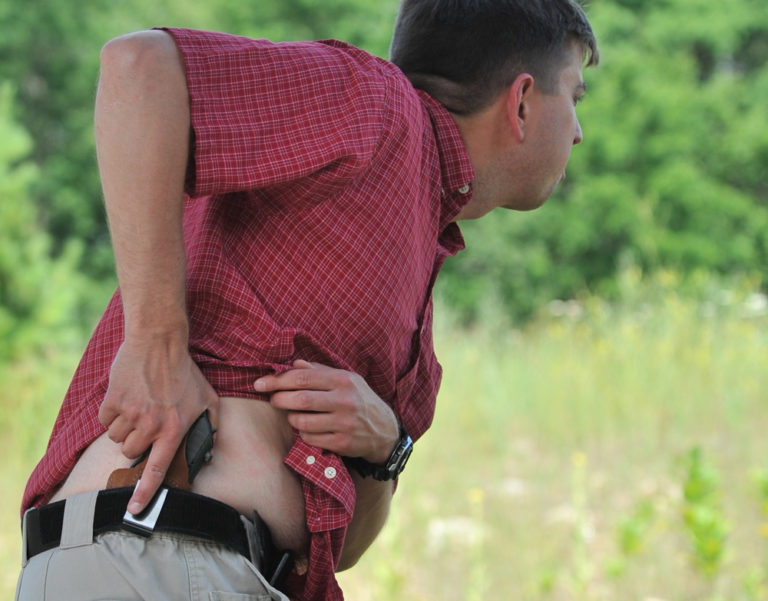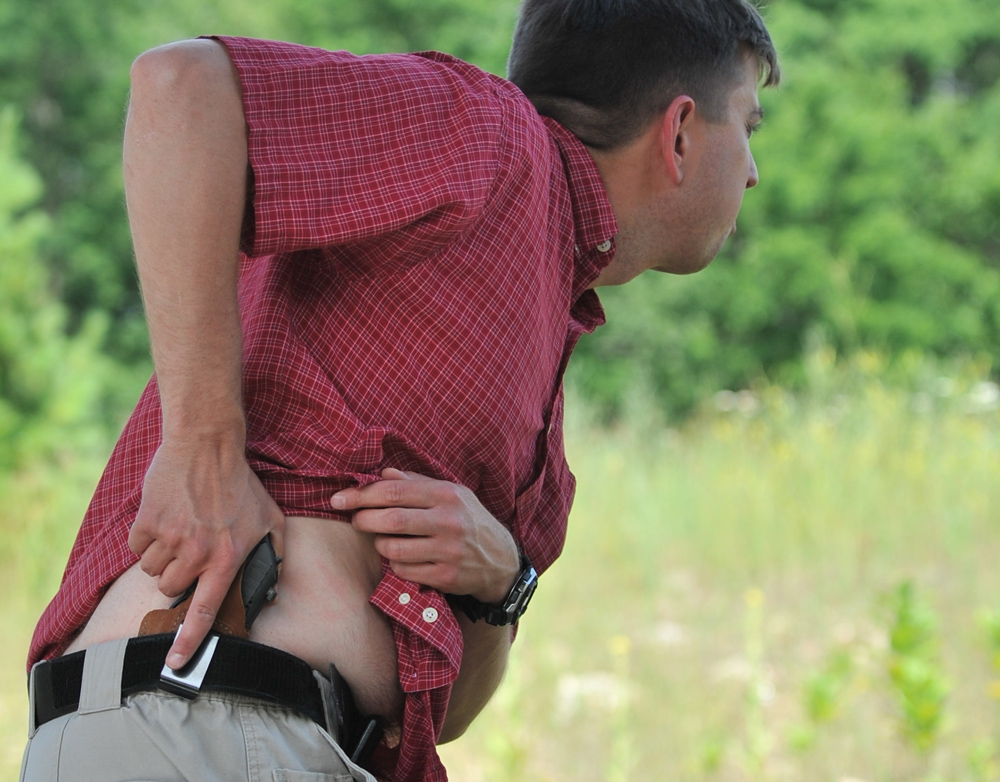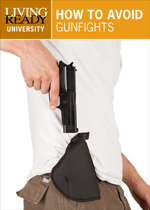

Here are 3 reasons why you should take the “Good Ready” approach rather than rely on quick draw when it comes time to defend yourself with a handgun.
Back in the day, we referred to pulling the gun from a holster as “the draw,” and speed of the draw was a much sought-after skill.
If a cop in training couldn’t get the gun out of a retention duty rig and engage a target (starting with a good grip on the gun) in less than one and a half seconds, they were not ready to go on the street.
With fast hands and lots of practice, an officer can punch out two rounds center mass at contact distance, in about three-fifths of a second.
Cops have to be fast because their job requires them to closely approach an unknown-risk subject. It may place them behind the action curve if that subject makes a quick move for a gun or knife.
If you're not a police officer, you (thankfully) don’t have that obligation and I would much rather you concentrate on a “good ready” than a quick presentation. Here’s why:
- Practicing “quick draw” is one of the most dangerous of all firearm training activities (which is why most ranges prohibit shooting from the holster). Keep your trigger finger outside the guard until you are on target. Do not practice fast presentation with a loaded weapon! Have a room for presentation practice only and never take ammo into that room.
- Many concealed carry holsters do not stand up well to repeated grabs. If you are truly committed to becoming smooth and quick — and that means at least 250 replications — get two identical holsters, one for practice and one for regular wear.
- When pumped up on the adrenalin rush of a sudden threat, fumbles are likely. It's better to get a good, early grip on the gun rather than rely on speed of the draw, if at all possible.
What is a “good ready” for a civilian? It means situational awareness at all times and taking proper defensive action prior to the need to present the weapon.
From one hundred feet, identify potential threats and move laterally to avoid them. From fifty feet, if you have a specific threat, and the totality of the situation demands it, go to your shooting stance and get your hand on the gun under the concealing garment. From twenty feet, if the threat has the apparent intent and capacity to do you lethal harm, smoothly draw and present in a “low-ready” position and issue your verbal warnings. From closer than 20 feet, an attacker can close the distance and grapple you before you can get the gun out.
What about crowds? If the sociology of the crowd is benign then stay to the edge, note your exits, have a discrete impact weapon in your hand and hope for the best. If the crowd is questionable, you have already made two tactical mistakes: You have sacrificed distance and voluntarily placed yourself in a high-risk environment. (Let’s see if you can explain that to the D.A.)
If you carry a gun but not a badge don’t worry about “fast.” Instead put time on your side … and get a good ready.
Editor’s Note: Got a question for Joseph Terry about concealed carry not covered here? Log in and post your question in the comments below.
 Want to learn more from Terry? Get his How to Avoid Gunfights – Living Ready University Online Course instant download.
Want to learn more from Terry? Get his How to Avoid Gunfights – Living Ready University Online Course instant download.

![Best Concealed Carry Guns In 2025 [Field Tested] Wilson Combat EDC X9S 1](https://gundigest.com/wp-content/uploads/Wilson-Combat-EDC-X9S-1-324x160.jpg)


![Best 9mm Carbine: Affordable PCCs [Tested] Ruger Carbine Shooting](https://gundigest.com/wp-content/uploads/Ruger-Carbine-Shooting-100x70.jpg)
![Best AR-15: Top Options Available Today [Field Tested] Harrington and Richardson PSA XM177E2 feature](https://gundigest.com/wp-content/uploads/Harrington-and-Richardson-PSA-XM177E2-feature-100x70.jpg)

I call BS. This is a poor article. DRFTraining and Paul_Carlson are right.
DRFTraining is anti cop. Bad form dude. “Seriously shocked” indeed. Remind me not to “DRF” train.
I’m seriously shocked that someone with so much “experience” would write an article with so much misinformation. So because someone may not be at as much “risk” as an LEO, they don’t have an obligation to be fast, to defend themselves, or another?
I think the best way to approach this article is the same way as Mr. Carlson above me has.
1.) Crawl, Walk, Run. You can SAFELY teach people to draw from a holster and work them up to being faster (not outside their comfort zone) gradually. Most ND’s I’ve seen are a result of a speed “reholster” than a from a draw. I guess you don’t believe in the fact that defensive skills should be taught in a graduated circumstance? Just out of the gate everyone go for their gun as fast as they can? Or maybe silly civilians don’t possess that “skill set”. That’s something that only cops are born with.
2. If you have a holster that doesn’t stand up to repeated grabs, then you don’t have a holster, you have a paper bag. With the technology in today’s kydex holsters especially, your holster should stand up to 25,000 plus draw strokes. I use both hybrid (kydex w/ leather backing) and full kydex holsters and even in force on force classes where your body is being slammed into the ground on top of the holster, I’ve yet to see an issue.
3. Your talk about distances, and “adrenaline pumps” is 1, poorly researched, and 2, an opinion at best. Most instances where we need to use a hand gun may have some visual or auditory cues but in most cases we will be caught off guard with a surprise attack. As a police officer, you should know that. Yes, there are cues we can look for but spending your whole day in “condition red” is a bit exhausting and unrealistic.
My suggestion would be that you school yourself on how the world operates in 2014, stop relying on past, antiquated training, and get a bit of a grip on reality and realize that a good majority of CCW holders spend more time training than your LEO friends.
Paul I want to retort to one point in your comment:
“It is very unlikely to have the opportunity to identify threats at 100 feet”
If you think you are going to identify your threat 100 feet out you are setting yourself up to be disappointed by reality. You see, most people find out that they are involved in lethal violence when they recognize that they are being hit, kicked, cut, stabbed, shot at or shot. To be ready you need to be prepared to deal with the reality of violence, a surprising, chaotic, violent encounter at close distance.”
If you think your violent perp has not identified you by 100 ft, think again. As such, you should be able to ID a likely threat by then also. I’ve seen a practice drill involving two unarmed men standing 21 feet apart. Upon command, one man rushes the other, who remains in place, and as quickly as he can, reaches in his pocket and back out and points his finger at the rusher. This drill had no explained benefit other than to show how difficult it is to produce a gun and aim it effectively at a rushing threat. Let the rusher get a head start with momentum and it’s even more difficult. Your CC handgun probably won’t help in this scenario. If your second paragraph were true, then the way to train to draw your CC handgun should be under physical duress. Do you suggest that CC permitted citizens train this way?
I’m not really sure where to start on this, so I will keep my comments to the three numbered tips given in the article.
“1. Practicing “quick draw” is one of the most dangerous of all firearm training activities (which is why most ranges prohibit shooting from the holster). Keep your trigger finger outside the guard until you are on target. Do not practice fast presentation with a loaded weapon! Have a room for presentation practice only and never take ammo into that room.”
Presentation from the holster certainly has risks as do all activities that involve the use of a loaded firearm, however, due to the fact that drawing the gun from the holster is a certain prerequisite to using the gun to defend yourself or those that you love the benefits of learning to draw a loaded gun far outweigh the risks. Instead of learning how to draw a gun through dry practice, I recommend seeking qualified instruction. Having the skill to safely and quickly present the gun from the holster is certainly worth it should you need to defend yourself.
Someday I hope to have a room that could be dedicated to dry fire practice and dry fire practice only. When that day comes I will move my reloading equipment in the room immediately. that way the room can be put to a practical use.
“2. Many concealed carry holsters do not stand up well to repeated grabs. If you are truly committed to becoming smooth and quick — and that means at least 250 replications — get two identical holsters, one for practice and one for regular wear.”
If your concealed carry holster cannot stand up to repeated repetitions of a presentation from the holster, you simply have the wrong holster. If you cant count on it being able to deal with normal use I would imagine it is going to have a hard time performing the rest of its duties on a regular basis. You need a holster that covers the trigger guard of the gun so that it will not be accidentally activated. The holster must also hold your gun securely in place relative to your body even if your body ends up in an odd position such as feet in the air. Your concealed carry holster should have a mouth that remains open even without the gun in the holster so that you may easily re-holster when the time is right.
A quality holster will do all of the things listed above AND stand up against repeated use and practice of your presentation from the holster. You don’t need two holsters, you need one good one!
“3. When pumped up on the adrenalin rush of a sudden threat, fumbles are likely. It’s better to get a good, early grip on the gun rather than rely on speed of the draw, if at all possible.”
This statement contradicts itself and misleads the concealed carry practitioner. when we are faced with a “Sudden threat” an “early grip” on the gun is an impossibility.
We simply cannot grip the gun until we know there is a threat and that our concealed carry handgun is the solution to that threat. There certainly are circumstances that would allow for an early grip on the handgun and should one of those circumstances present itself a grip on the firearm would reduce the overall response time, however, these situations are few and far between.
It is very unlikely to have the opportunity to identify threats at 100 feet, evade at 50 feet and engage at 20. Empirical evidence shows that in excess of 90% of violent crime takes place inside 7 yards. Closer than 21 feet… Let that sink in.
If you think you are going to identify your threat 100 feet out you are setting yourself up to be disappointed by reality. You see, most people find out that they are involved in lethal violence when they recognize that they are being hit, kicked, cut, stabbed, shot at or shot. To be ready you need to be prepared to deal with the reality of violence, a surprising, chaotic, violent encounter at close distance.
Gun Digest, you can do better than this.
Appreciate your insights Paul_Carlson. Knowing your background and experience would add cred to your post. My cop son would agree with your point(s). As with all things opinion, me thinks the truth lies somewhere in the between. Personally, as a concealed carry, I want both–a quick (when necessary) AND a good ready (when possible) grip!
I want to thank the readers who took the time to comment on the piece. Every exchange of ideas advances our craft. I try with these posts to reach the average CCW holder who (in my experience at least) is not likely to, (a) be a hobby shooter,, (b) attend advanced tactical training classes, or (c) spend a lot of time reading about various training protocols. We are experiencing the growth of a CCW “industry” and in many ways that is a good thing, but it has also tended to create an expectation that to be competent, you have to be equipped and trained to a standard that the vast majority of permit holders will never achieve. This can challenge the confidence of that average Joe (or Jane) and inject doubt in a domain in which doubt can be deadly.
I’m just trying to build confidence with short pieces that must by necessity involve oversimplification. Guilty as charged. (The editor generally provides the headline.)
Every one of the points made in the critiques is valid from the perspective of the contributor as mine are valid based upon my experience. It would be wonderful if the average permit holder could be trained to the level necessary to present from the holster at a competition-level pace. It would be great if we spent more time teaching threat avoidance and handgun retention. It would be terrific if the average permit holder tried many holsters to find one that is both durable and quick-in-action.
My experience with the affect of adrenalin on psychomotor dynamics is personal and the product of interviews with many people who have been in harm’s way with a gun. No controlled experiment can replicate the “average” armed encounter so all expressions of “fight-flight-or-freeze” are anecdotal or author opinion. (I would really appreciate it if I am in error if a reader could provide a citation to a reputable medical journal.)
What do we agree on? More training is always a good thing. Trying various combinations of equipment is a great confidence builder. But please, let’s not denigrate the person who buys a gun and a holster, takes the class and gets a permit with “If they were truly serious…”
You further comments are always appreciated. Joe